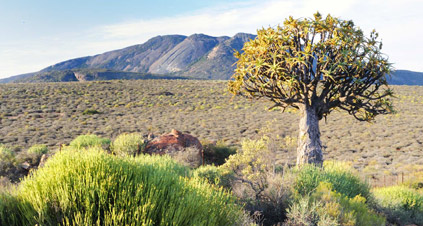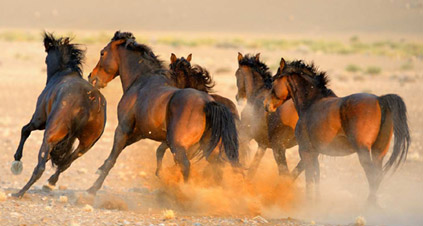
Cape to Richtersveld 2010
23 September 2010 – The group decided we wanted to follow up on our visit to the Namaqualand and Richtersveld area in order to guage the sustainability of our programme. We departed from Cape Town along the N7 to the North with the aim of overnighting at Kookfontein, the un-commercial oasis in the Namaqua National Park (NNP). The nearby village of Soebatsfontein is directly on the border of the NNP, and also our entrance to the park.
Due to management reasons, Kookfontein is not open to the public but, because of our involvement with the Park, we were given the privilege to overnight under the palm trees and to swim in the nearby fountain dam. After a five- hour drive we arrived at camp and pitched our laager of tents for the night. The amazing constellation of stars officially greeted us in big sky country.
24 September 2010 – The Southern masked weavers woke us with the wind whistling down the valley. Due to early rains and subsequent heat in between showers, the quantity of flowers in Namaqualand was less spectacular. Following the jeep track back to town, evidence of the resident leopard was found in the dry stream bed. The locals who we had befriended the previous year greeted us warmly at the local school.
It was holiday time and our programme was adapted to an outdoor holiday programme. The children, some of whose faces were familiar to us, helped us offload and soon we started by drawing a large bird of prey in the playground soil. The aim was to get them to experience the flight of ab eagle and soon they took off to the left wing, right wing, tail… and any ice between children and us was completely broken.
Our next mission was to focus on waste management and to clean the school grounds and surrounding drainage lines. We ventured into the veld surrounding the school with a focus on the town’s water source. We noticed how clean and proud they were about this groundwater resource. Back at the school we made land art from all the waste that was collected. Everyone participated and we created an abstract colourful bird figure.
The importance of recycling and waste management was effectively communicated. From the plastic bottles retrieved we demonstrated how one can make recycled bird feeders, and how we can use old food as feed. These feeders were placed in large trees with immediate results, attracting common garden species of birds. This time around we were able to give each child a football and a T-shirt with a Verreaux’s eagle printed on it. We donated a term’s worth of art material to the school. We also engaged with the local park rangers and equipped them with clothing for the bush and binoculars and camera harnesses. Back at camp we enjoyed a swim in the fountain and did some birdwatching for the rest of the day.
25 September 2010 – Our journey continued through the NNP to Skilpad base where we met up with the Park Ranger for an information session on the Anatolian Sheepdog project. The park, as part of their predator conservation project , breeds these unique dogs which have the ability to adopt a flock of sheep and goats, effectively protecting them from predators such as leopard and caracal. This in turn ensures lower mortalities through human intervention among predators and a better balanced ecosystem in the long run. From here we headed for the Richtersveld Community Conservancy (RCC) and, in particular, the Rooiberg Community Guesthouse 10 km from Eksteensfontein . We were pleased to be back in this mountain desert and our hosts at the guesthouse from the local community were very helpful in putting us up for the night.
26 September 2010 – Due to the cold weather we were all wearing longsleeved jackets and pants, but the 4x4 route taking us through the Orange River gorge to our campsite at Kannikaip, warmed the blood of all. The dust and fresh mountain air accompanied us as we were drawn deep into “no-mans land”. Five hours later we entered the open valley of the Orange River, snaking through the red mountains. After some hard 4x4-ing we reached a picture perfect beach with grass embankment that we made our home for the evening. The sun came out for the first time on the trip as we played soccer on the beach. This justified bathing in the river as everyone settled in for a sundowner of note. The gurgling sound of the river soothed us into a deep and satisfying sleep.
27 September 2010 – We did not want to leave this paradise but we had an appointment with a small community at Kotzeshoop, east of Kannikaip. Our route was described on Tracks for Africa as “not recommended” and another traveller reported to us that there was no road along the river. We found a faint track and our confidence in the endurance of our vehicles steered us east on the river. We literally did boulder-hop across deep soft sand. Fortunately we lost only one tyre – on the vehicle of photographer Peter. Operating high-lift jacks and dealing with thoughts of turning back helped to further bond our group. After a while the boulders became fewer and the track harder and a group of wild horses eventually led us to signs of civilisation. We were an hour late for our appointment and the children were waiting at the entrance road to the township. We were escorted by laughing and running kids up to the school yard with its very welcome shady stoep and trees. We enjoyed another fulfilling programme, helping the elderly and shortsighted with reading glasses, and left the streets of Kotseshoop filled with children playing football. After crossing the border into Namibia, we were met with the spirit of river rafting in the Abiqua camp. Fortunately we had reserved a riverfront campsite with large trees as there were many river rafters revelling in the peak of the rafting season.
28 September 2010 – Our next destination was Aussenkehr, a small town developed around the table grape export industry. The village is located on the banks of the Orange River in Namibia, with most of the houses build of reeds due to its availability on the river and the fact that it is a good insulator. It was a remarkable site with an unbelievable green vineyard landscape which appears out of nowhere.. Our mission was a visit to the local safe haven for orphan children in Ausssenkehr. Here the kids get fed daily and a safe environment after school is provided. Our intention was to put smiles on faces and to investigate how we could offer further support to the children.
We gathered in a church building with a corrugated roof and high reed walls, the breeze blowing through the building were remarkably cool. I drew an large raptor on the floor, and the kids took off… flying freely. This imaginary game lifted the spirits of all present. Using an apple to demonstrate the percentage of water vs. land on our planet illustrated how important the 30% of land is that we live on. We collected litter around the church grounds and that was transformed into bird feeders. The trees were neatly decorated with colourful recycled bird feeders and they attracted birds immediately. After handing out soccer balls, T-shirts, sunglasses, art material and reading glasses we departed to Norotshama Reserve where we killed the midday heat in the pool. Late afternoon we departed for our desert camp site, approximately 15 km away from the river in the desert at an oasis know for its wild horses. We arrived at the camp on the edge of an ancient floodplain, with only a small farm where we cooled off after a game of desert soccer.
29 September 2010 – Early in the morning the first desert horses appeared; they were skittish as they came to drink while we observed their careful movement. We happily spent the day river rafting and drifted effortlessly through the floodplain, entering the rugged mountains of the Ai Ais Hotsprings & Richtersveld Transfontier Park (TNP). We spent three hours on the river, birding and completely missing the heat of the day. Our campfire proved an attraction for scorpions that night, reminding us of the dangerous environment we were in.
30 September 2010 – After departing our memorable campsite in the desert, we drove along the Orange River towards the west where we entered the TNP. The winding road followed the river and limited evidence of human habitation existed, except for abandoned diamond mines and one brave subsistence farmer offering camping on the river banks. We crossed back into SA over the pontoon at Sendlingsdrift. From the Namibian side we recognised the group of waving children who we were about to engage with. It was moving to recognise some children from our last visit with the same soccer balls from our previous visit under their arms. We engaged with the Sanddrift primary school children at the Environmental centre at Sendlingsdrif in the Richtersveld National Park (RNP). Since our visit they have formed an environmental club and the kids were extremely knowledgeable, remembering bird names and recognising birding behaviour. This proves to us that the project is indeed sustainable and it has a positive impact on the children and the communities they represent. Not even Chris’s trailer that was written-off 1 km outside of Sendlingsdrif could dampen our spirits, while we entered the RNP towards the De Hoop campsite.
1 October 2010 – Waking up at De Hoop campsite, we knew we could relax and absorb the open space. This made us appreciate this natural wonder even more. We hiked, swam and birdwatched the entire day, enjoying the reflection of a tremendous successful return trip. We decided to return to the area and visit the communities and children we befriended, in order to continue the support E Snell & Co provide as part of their corporate social investment programme.
2 October 2010 – We started our long trek back to the Cape of Good Hope, scouting the towns we had not yet visited. Lekkersing was reached after experiencing the longest corrugated road we’ve ever travelled in South Africa. The town was very quiet on a Saturday afternoon with evidence of a once booming mining period. We ended on the R382 leading us back into Namaqualand. Our overnight destination was a traditional Namaqualand farm named Arakoop, 50 km south of Springbok. Comfortable traditional historic cottages set among granite hills allowed us to finally contemplate our successes on the outreach trip and mull over what is to come in the future.









